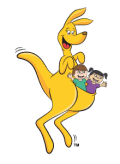Dr Tessa Grigg and Bindy Cummings
The music at GymbaROO-KindyROO was initially developed as another way to add to the fun and enjoyment of our classes and to extend physical and language skills for children. However, over the past 35 years, while ‘GymbaROOers’ have been singing, dancing, moving and playing musical instruments, research has been steadily proving the significant role that music plays in development during the early years. Neuro-scientific studies now confirm that music encourages skill development in auditory processing, verbal memory, language, speech processing, perception, coordination, literacy, mathematics and more. We at GymbaROO-KindyROO are continually integrating this research to ensure that our music specifically meets the developmental needs of babies and young children. GymbaROO-KindyROO music is predominantly duple metre (march) time. It is well acknowledged that duple metre has a significant effect on brain development and is music that children respond to easily1. We also provide variety so that children are exposed to a range of musical beats and styles. At times we include music that provides more challenging temporal structures, for example; waltzes (triple metre) and classical music, especially music by Mozart, Vivaldi and other music from the Baroque period, as is very stimulating to the developing brain.
The songs chosen or written for the GymbaROO-KindyROO programs incorporate developmental sequences and are recorded at a speed that allows children to complete the actions and build a range of skills. Our music contains appropriate and suitable language for young children with positive messages and most importantly, the songs are delightful and enjoyed by all, young and old.
What parents can do
- Provide musical experiences at home for your child. Play and sing music that is being used during your GymbaROO classes. Repetition is an excellent and important learning tool. Being familiar with the music allows your child to focus on the actions during the class and at home. This improves the depth of learning and promotes an increased sense of confidence, whereby extending and strengthening your GymbaROO experience.
- Purchase a few good quality instruments. Rhythm sticks, maracas, triangles, wood blocks and tambourines are inexpensive yet add a different dimension to music at home. Make some instruments of your own – stones in a plastic bottle make a great noise, as does an old pot-lid and a wooden spoon. Dance with your child, sing songs to them and listen to a wide range of music. All of this will help your child develop a broad range of skills.
References: 1. Hannon, E. E., & Trehub, S. E. (2005). Tuning in to musical rhythms: Infants learn more readily than adults. Proceedings of the National Academy of Sciences of the United States of America, 102(35), 12639-12643. doi:10.1073/pnas.0504254102

